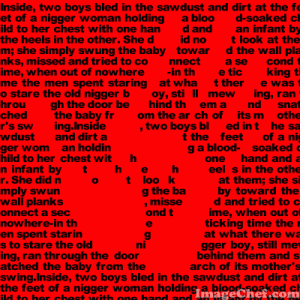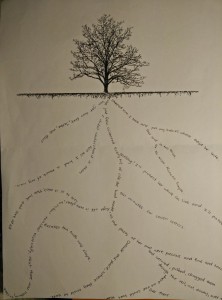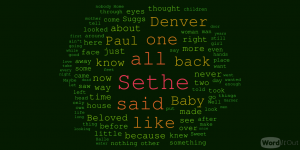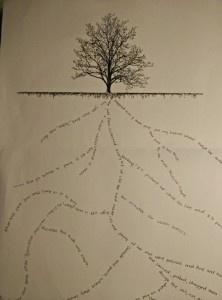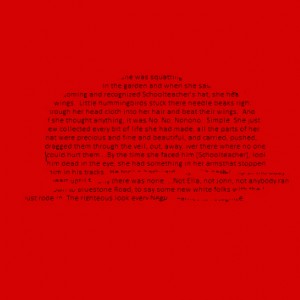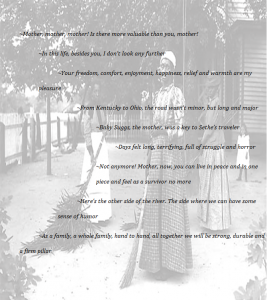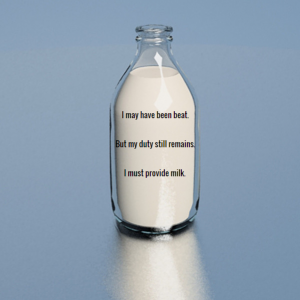I have created a concrete poetry image to represent the scene that I have chosen for part one, which I believe was a central scene in the book. This scene was when Sethe killed her two year old child. This image was created on a website (imagechef.com). I chose the shape of a hand with the words wrapped around it. The hand is meant to represent Sethe’s hand. My intention in wrapping the words around the hand was to represent the pain that surrounded Sethe after she had killed her child. The color for the hand, red, represents the blood of the child in Sethe’s hand. The text around the hand is the text from the scene. After the horsemen came to claim her and her children to take back to Sweet Home, Sethe believed the only way to save them was to kill them all. She did not want her children to die as slaves, at the hands of another. She wanted them to die from her hands, while they were still free. In choosing this shape for the text, I believe it shows the significance of Sethe’s hands in the story, which was used to kill her child and the importance of this scene in the book.
Category Archives: Gallery
The tree of Slavery
Slavery is like a tree in that it is rooted in history, and rooted in the lives of everyone in this society. The tree looks big, strong, and even beautiful but what is not seen in the naked eyes is the roots of the tree. Like the tree, the roots of slavery is still around today even though we do not see it. There is still discrimination and prejudice against black people even though slavery is abolished. Like the tree in Beloved, Sethe is ashamed to see the beauty of it even though it represents the tree where the other Sweet Home men may have been lynched.
Some quotes deeply rooted in the history of slavery that resonates with me are those involved in Sethe’s (and other slaves of the time) need to claim something during slavery. She has a strong desire to prevent her children from experiencing what she has experienced in Sweet Home. In order to put her children somewhere safe, the only escape is death. Stories like such are the roots of slavery that will never be erased from history even though we do not actively think about or see it in today’s society. This artwork is trying to bring sight to the roots of slavery and how it will always stay with us no matter how far we have improved since then.
Slavery is seen as something that is worse than death, something that could affect their kin several generations down. We are still experiencing the aftermath of slavery whether it is racism or prejudices. This brings to mind the question: when will slavery’s possession on civilization ever end?
Project 2 Part 2
For Part 2 of the project i made a word cloud that represented the entire story. I did the entire story because the words that most come up would be a good representation of what the story would be about and who would it go around. The word cloud shows that Sethe is what the story is focused on and it will mostly go around what is happening in her life and all the choices that she makes. The word cloud also tells us which characters are also important and can find what kind of relationship they have with Sethe and the story they have with her. As readers get to read the book and know what meanings such as “baby” and “Beloved” mean they can see the importance they have in the book.
The tree of Slavery
Sethe’s Worst Fear
This image of a hat is a representation of what can be described as the trigger that set Sethe in motion and led her to gather her children and take them to the woodshed where she felt they would be safe. In the woodshed the most pivotal moment in the novel occurred. She managed to kill her first daughter on whose headstone the word, “Beloved,” the only word Sethe could afford was inscribed.
It was by chance that Sethe was squatting in the garden and manage to see Schoolteacher’s hat hovering above the garden fence before he saw her. She knew his presence there, at the house at 124 Bluestone meant only one thing, a return to slavery for her and her children. Sethe had experienced slavery and knew its harsh realities. She knew what it was like to be beaten, treated and classified as an animal and not able to love anything or anyone for fear they could be separated and killed or sold at any time. Noticing the hat before the wearer saw her gave her a head start that changed the course of her life and that of her family. Her mind and body worked at high speed, pushing, shoving and dragging her children into the woodshed. Then she lost all rationality, “no, no, nonono,” she repeated as she made the decision that death was safer than slavery for her and her children. That was the worse decision of her life. This is because after that unfortunate day, not only did she have to live with her conscience she also had to live in a house haunted by the baby, endured being shunned by the towns people and the loss of her two sons who ran away from her. Her worst suffering came when Beloved the reincarnation of the dead baby returned for revenge.
Robbed
Robbed
I am broken.
For the very thing that I had that was near to me, has been lost,
It was the very thing I gave birth to,
It was a source of nourishment,
A place for my youngin’ to satisfy her need,
It was my mine,
IT BELONGED TO ME!
IT WAS MY MILK!
But where has it gone?
To the mouths of the white girls,
To the mouths of the white boys,
What about my youngin’?
What will she have?
I kept it safe for her,
I made sure I took care of myself,
I did everything a mother was supposed to do.
Now, what can I give to you my child?
I have nothing to offer to you,
My bosom is empty and my heart is empty,
If I had, I would have given you the world,
But sadly I have nothing to give to you, my sweet child.
Forgive me, for one day I will repay you.
This poem is about Sethe getting her milk robbed from her while she was a slave at Sweet Home. In Beloved, “those boys [the nephews of the Schoolteacher] came in there and took her milk…they held her down and took it…Schoolteacher made one [of the boys] open up her back and when it closed it made a tree…they used cowhide on her and took her milk…they beat her while she was pregnant and they took her milk” (Morrison 19-20). As I wrote this poem, I wrote it as if Sethe was describing her anguish for her milk getting robbed and the remorse of not having it to give to Beloved. I also wrote it as if Sethe was going to restore the bonding between herself and Beloved, since Sethe did not have any milk to give to Beloved when she arrived to Ohio. Now, addressing the section where I state, “to the mouths of the white girls, to the mouths of the white boys,” I got that idea from when Sethe explains that her milk was being taken from her to be given to the young white children. Slaves, including Sethe, would be assigned to breast feed other children besides their own. In Sethe’s case, she was not breast feed by her own mother.
Ooooh Baby Suggs!
The second part of the project I have chosen to express and demonstrate the scene in a form of a poem with an expressive picture in its background.
The scene I talked about in part one is when Baby Suggs got her freedom and moved to Cincinnati. Halle worked hard even weekends to make enough money to free his mother. I personally find this act very touching and heartbreaking. Selfishness stops behaving at some point when we deal with some categories of people such as family.
The poem is told in first person, using Halle’s voice. The poem expresses the value of the mother and the joy she deserves. It is mentioned that Baby Suggs welcomed the travelers, it is meant here by whom who followed her later on to Cincinnati and join her in her house. The path Baby Suggs has taken and her move to Cincinnati was also described in the poem as I said “Days felt long, terrifying, full of struggle and horror ~Not anymore! Mother, now, you can live in peace and in one piece and feel as a survivor no more.” It is noticeable that this wasn’t easy to happen and wasn’t a walk in a park.
“The side where we can have some sense of humor.” the side cross the river is the place where Baby Suggs has moved. It is obvious that people have no sense of humor being slaves but this was generated and reborn again in their lives after their freedom.
The picture in the background shows two mature women whom are represented as Baby Suggs and Sethe surrounded by Sethe’s kids in their new home in Cincinnati.
PROJECT #2 / PART 2
I may have been beat.
But my duty still remains.
I must provide milk.
What I decide to do for project 2 part 2 is a haiku inserted in a picture of a milk bottle. Now what exactly is a haiku? A haiku is a poem that consists 5 syllables on the first line, 7 on the second, and 5 on the last. This all adds up to 17 syllables.
The pivotal scene I chose for Part 1 of this project was the scene where Sethe was beaten down and had her milk stolen. This scene brought about many events in the story. Without those events, the story would have played differently.
As we know, Sethe developed sort of an obsession to provide her children with her breast milk. When she developed her own milk, all she could think about was giving what she couldn’t have as a child. However at one point of the story, Sethe was attacked by schoolteacher’s nephews and had her milk sucked right out of her (I may have been beat). Although this left a stain in her mind, she still wanted to give. It was her duty (But my duty still remains) and obsession to nurse her children (I must provide milk) Throughout the story we see this obsession and we see that she wanted to be the best mother she could.
For the haiku, I had to think pretty hard on how I wanted to write it. You’re limited to what you can write and there’s a set format you have to follow. I wanted to portray Sethe’s image as a dedicated mother while bringing up the milk robbing incident. As a result, I came up with what you see. To add a bit more creativity, I decided to use a simple image of a milk bottle (It was hard to pick one) and simply edit the haiku text inside it. The milk bottle (which can be seen as a bottle of cow milk) represents in which I believe is the way she was treated. Like most slaves, Sethe was treated poorly and it seemed like she was treated more as a cow than a human. Like a cow who has no control of who takes her milk, Sethe had no control in this situation.

